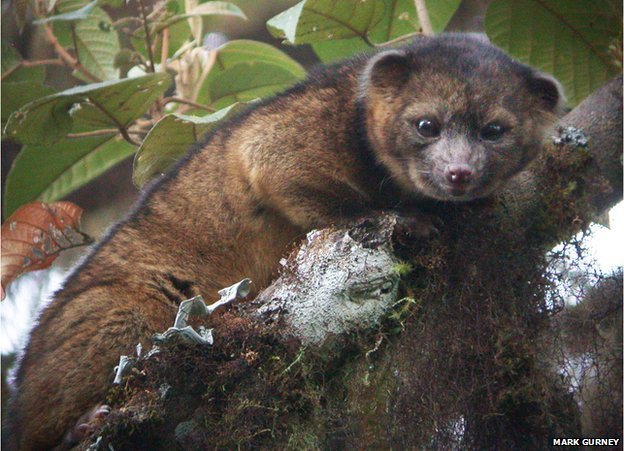
US scientists have discovered a new animal living in the cloud forests of Colombia and Ecuador.
It has been named olinguito and is the first new species of carnivore to be identified in the Western hemisphere in 35 years.
It has taken more than a decade to identify the mammal, a discovery that scientists say is incredibly rare in the 21st Century.
The credit goes to a team from the Smithsonian Institution.
The trail began when zoologist Kristofer Helgen uncovered some bones and animal skins in storage at a museum in Chicago.
“It stopped me in my tracks,” said Kristofer Helgen.
“The skins were a rich red colour and when I looked at the skulls I didn’t recognise the anatomy. It was different to any similar animal I’d seen, and right away I thought it could be a species new to science.”
Dr. Kristofer Helgen is curator of mammals at the National Museum of Natural History in Washington DC, which houses the largest mammal collection in the world.
More than 600,000 specimens are flat-packed in trays to save space, their bones picked clean by specially bred beetles and stored in boxes alongside their skins.
Many were collected more than a century ago and were often mislabelled or not properly identified. But recent advances in technology have enabled scientists to extract DNA from even the oldest remains.

The 14 in-long olinguito is the latest addition to the animal family that includes racoons. By comparing DNA samples with the other five known species, Dr. Kristofer Helgen was able to confirm his discovery.
“It’s hard for me to explain how excited I am,” he says.
“The olinguito is a carnivore – that group of mammals that includes cats, dogs and bears and their relatives. Many of us believed that list was complete, but this is a new carnivore – the first to be found on the American continent for more than three decades.”
Dr. Kristofer Helgen has used such mammal collections to identify many other new species, including the world’s biggest bat and the world’s smallest bandicoot. But he says the olinguito is his most significant discovery. Its scientific name is Bassaricyon neblina. The last carnivore to be identified in the Americas was the Colombian Weasel.
But even after identifying the olinguito, a crucial question remained: could they be living in the wild?
“We used clues from the specimens about where they might have come from and to predict what kind of forest we might find them in – and we found it!”
The olinguito is now known to inhabit a number of protected areas from Central Colombia to western Ecuador. Although it is a carnivore, it eats mainly fruit, comes out at night and lives by itself, producing just one baby at a time.
And scientists now believe an olinguito was exhibited in several zoos in the US between 1967 and 1976. Its keepers mistook it for an olinga – a close relative – and could not understand why it would not breed. It was sent to a number of different zoos but died without being properly identified.
“The vast majority of the discoveries of new species are made in museum collections,” says Chris Norris, of the Yale Peabody Museum of Natural History in Connecticut and president of the Society for the Preservation of Natural History Collections.
“Often people working 70 years ago or more had different ideas of what constituted a new species – maybe they didn’t recognise things that we would as being distinct, or they might not have had access to technologies, such as being able to extract and sequence DNA.”
But there is no central museum database and scientists have little idea of what each collection contains. Many organisations are now putting their inventories online, and Dr. Chris Norris says that will make research faster and more accessible.
Another challenge is keeping specimens in good condition. Many are hundreds of years old and are prone to moth and insect infestations.
The oldest surviving collection was assembled in the 17th Century by John Tradescant. Its most famous specimen is a dodo that is now on display at the Oxford University Museum of Natural History in the UK.
“But not all of it,” says Dr. Chris Norris.
“There’s just the head and a foot left because everything else got eaten.
“It’s a cautionary tale for anyone working on museum collections today. You get to do exciting science but you have to take care of them or they won’t be there for people to use in the future.
“Our economy is in the middle of a rough period and spending on museums sometimes seems difficult to justify when you look for example at some of the more shiny or spectacular scientific tools that are out there. But it’s important to think of these things, not as rather bizarre collections of dried skins and pickled bats in jars and drawers full of snails, but as a research tool in the same way that you might think of a new telescope or a Large Hadron Collider.”
Scientists have catalogued only a fraction of the planet’s lifeforms. New species of insects, parasitic worms, bacteria and viruses are discovered on a regular basis, but new mammals are rare.
“This reminds us that the world is not yet explored and the age of discovery is far from over,” says Dr. Kristofer Helgen.
“The olinguito makes us think – what else is out there?”
[youtube f3OJQokU_Xw]